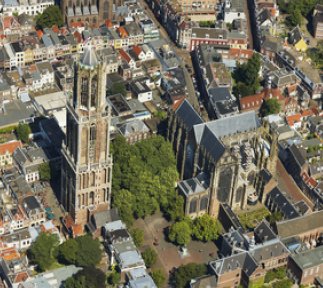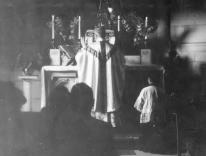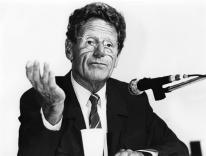 I hate this subject. I have hated it since 1988, when, in the springtime of my own faith, I learned that a priest in my hometown parish had abused altar boys there. I have hated it since 2002, when the abuse question exploded in the U.S. church and it became clear that the self-assessment and reforms of the 1980s and ’90s had been dismally inadequate. And I hate it now, watching the same story unfold in my present homeland of the Netherlands.
I hate this subject. I have hated it since 1988, when, in the springtime of my own faith, I learned that a priest in my hometown parish had abused altar boys there. I have hated it since 2002, when the abuse question exploded in the U.S. church and it became clear that the self-assessment and reforms of the 1980s and ’90s had been dismally inadequate. And I hate it now, watching the same story unfold in my present homeland of the Netherlands.
What I find so painful is how it confronts me with the suffering and failure of people I love. For me, the Catholic Church is one great family in space and time, and this is family life gone badly wrong. The children who have been abused are my sisters and my brothers. But so too are the abusers, and those who covered for them, and those who looked the other way. Beyond this, I feel a great sadness, knowing how this scandal keeps people from finding God and experiencing his love for them. The church has this ultimate gift to offer the human race, the good news of Jesus Christ. But who will want our gift when our abuse is what they see? So when Commonweal asked if I wanted to report on the findings of the recent Deetman inquiry into sexual abuse in the church in the Netherlands, I can’t say I jumped at the chance. The last thing I wanted to do was spend the Christmas holiday immersing myself in this sordid history. But I came around. I owe it to the victims, and to the church. So here goes.
In March 2010, in response to increasing numbers of questions and complaints about sexual abuse within the church, the Dutch Bishops Conference and Dutch Religious Conference (KNR), commissioned an independent inquiry into the scope and nature of abuse in the Dutch Catholic Church since 1945. Wim Deetman, a Protestant, a former Minister of Education, and a former mayor of the Hague, was appointed to lead the inquiry. He was joined in the commission by a former judge, a clinical psychologist, a professor of psychology, a professor of the philosophy of science, and a professor of church history. Only the church historian is Catholic. Deetman was promised full independence and unhindered access to the archives of the Dutch dioceses and religious congregations and orders. When the commission released its report on December 16, 2011, Deetman complimented the bishops and religious superiors for keeping the promise of transparency and cooperation.
The report, comprising more than 1,200 pages, draws on several research methods (interviews with victims, family members, perpetrators, victims groups and church leaders; literature studies; a national survey; archive research; and more) and relates the findings to the country’s socio-historical context. As such the Deetman report (Sexueel misbruik van minderjarigen in de Rooms-Katholieke Kerk) offers valuable insight into the complexity of abuse as a phenomenon within the Church. Currently only a summary is available in English (at www.onderzoekrk.nl), but I presume the entire report will be translated soon.
The abuse in context
The period between 1945 and 2010 was a time of great change for the Catholic Church around the world, but even more so in the Netherlands. From the latter part of the nineteenth century up to the 1960s, the Catholic Church had stood as one of the pillars on which Dutch society was built, alongside the Protestant, socialist, and liberal pillars. Each of those four groups had its own network of businesses, unions, newspapers, schools, political parties, health-care, and recreational institutions. Members of each group tended to associate mostly with their own kind. More than that, they were dependent on one another for employment, political clout, and other kinds of social support. The four pillars, standing side by side in reasonable harmony, held the roof up, so to speak, over Dutch society.
In the 1950s and ’60s, however, that structure began to break down. Members of the various social groups associated more freely with one another, a process accelerated by secularization within the church. Both Catholics and Protestants viewed “the world” more positively and showed themselves less willing to accept the teachings and authority of church leaders. Most, though not all, Dutch Catholics, welcomed Vatican II. The Dutch bishops, acting in unified fashion, took quick action to implement the reforms and organized a national Pastoral Council (1968-1970) to discuss possible courses of action. At the Dutch Pastoral Council, even the question of clerical celibacy was put on the table. Rome looked warily on the developments in Holland and eventually reined them in by appointing conservative bishops, starting with Ad Simonis (appointed to Rotterdam in 1970) and Johannes Gijsen (appointed to Roermond in ’72).
As in the United States and the rest of Western Europe, church practice has declined significantly in Holland since the 1960s. But the rate of decline in the States pales before the decimation that the Dutch church has experienced. At the start of the ’60s, practicing Catholics made up well over a third of the country; the Netherlands was exporting more missionaries than any other country. According to figures from the Dutch Centraal Bureau voor de Statistiek, even as late as 1975, 38 percent of the population still identified itself as Catholic, and half of them attended church regularly. The most recent statistics show 28 percent of the population identifying itself as Catholic (in 2007), and less than 20 percent of Catholics attending church regularly.
It comes as no surprise, then, that in light of this steep decline in practice, most reports of abuse made to the Deetman Commission concern incidents that took place between 1945 and 1975, when it was far more common to attend a Catholic (boarding) school and be active in parish life. During that period, Catholics were also more dependent on the social network the church provided—especially when it came to employment. Catholic boarding schools are now a thing of the past, and thriving parishes, in which one finds all age groups amply represented, are a rarity. The painfully ironic “upside” to the decline in church practice has been that the overall number of abuse cases has also declined.
The findings
The Deetman report highlights two main conclusions: First, tens of thousands minors were sexually abused by representatives of the Catholic Church (priests, religious, and laypeople) in the Netherlands between 1945 and 2010; and, second, bishops and other church authorities knew about the problem and “in many cases…failed to take adequate action and paid too little attention to victims.”
Among the other notable findings are the following:
* The commission received 1,795 reports of sexual abuse occurring between 1945 and 2010. (Sexual abuse, as defined in the Deetman inquiry, includes minor to severe forms of sexual contact imposed against one’s will.) Based on those reports and other information, the commission drew up a list of approximately 800 “perpetrators” (people working for dioceses, orders, and congregations who have been accused of abuse). Of those eight hundred people, more than one hundred are still alive (if not employed). The commission has reported the names of the perpetrators to the bishops and superiors who have charge of them.
* Sexual abuse is a problem not confined to the church, but is widespread in Dutch society (population 16.8 million). One out of ten Dutch adults over the age of forty reports having been sexually abused before the age of eighteen by an adult who was not a family member. That figure derives from a national survey of 34,000 persons conducted, at the request of the Deetman commission, by the research institute TNS NIPO. That survey shows that 12.4 percent of Dutch Catholics reported having been sexually abused as a minor, while 8.4 percent of non-Catholics reported having been abused. (The Deetman report stresses that the survey says nothing about the identity of the perpetrators—in other words, they could have been family members, not priests.)
* People who had spent a significant portion of their youth in an institutional setting offering round-the-clock care (boarding schools, orphanages, seminaries) reported sexual abuse at a rate twice that of the national average (20 percent vs. 10 percent, respectively). In this, there was no significant difference between the rate of occurrence at Roman Catholic and non-Roman Catholic institutions. The commission estimates that ten thousand to twenty thousand minors were sexually abused at the Catholic institutions between 1945 and 2010.
Much in the report will sound familiar to those who have followed the abuse story in the United States, Ireland, Austria, and Germany. There are similarities in the patterns of how the abuse occurred, how victims experienced and dealt with the abuse, and how church leaders responded to the situation.
How the abuse occurred
Early media reports on the abuse in the Dutch church focused mainly on the cases that had occurred in educational and care institutions. The Deetman commission, by turning its attention to dioceses and parishes as well, provides a more complete picture. That is important because Catholic boarding schools, where many cases occurred, have disappeared. Parishes, however, have not.
A combustible mix of three factors made Catholic educational and care institutions dangerous for the children they served. The first was the vulnerability of the children themselves, removed from their parents’ oversight. Children with additional psycho-social problems (those who came from broken homes, for example, or those with a prior history of abuse) were especially vulnerable. The second factor was the lack of psycho-sexual maturity on the part of certain persons assigned to care for them (teachers, religious, priests). Among the priests and religious working in the institutions were some who had promised celibacy without having come to terms with their own sexuality or sexual identity. Those people showed themselves incapable of channeling their sexual feelings in healthy ways. Having many people like that in the same setting created environments of dysfunction, wherein harmful behaviors were tolerated, reinforced, and passed on, by way of example. The third factor was a leadership culture within the institutions that was excessively concerned with saving face. In many cases, leaders did intervene to stop abuse, but across the board they sought internal solutions that would not bring negative publicity. Religious superiors did not go to the police, and rarely notified the bishop when abuse had occurred. Instead, they usually reprimanded abusers and reassigned them to settings that were thought to be low-risk.
Sexual abuse within Dutch parishes typically occurred in rectories, sacristies, parishioner homes, or parish schools. A recurring pattern shows the abusive priest or religious ingratiating himself with the victim and his or her family. The abuser commonly takes charge of youth activities in the parish. “Playful” approaches lead to physical contact and eventually to unwanted contact in unsupervised settings. The Deetman report found that in some cases alcohol abuse or financial problems have been significant in the abuser’s personal history, and that many abusers have themselves been abused.
The victims’ experience
Deetman makes clear that sexually abusive encounters have induced great suffering in the victims. Many have felt ashamed of their victimization and have kept the abuse a secret for decades. Some were, in the course of or aftermath of their abuse, threatened with reprisals for themselves or their family should they tell. Victims who looked to others for help (parents, the abuser’s supervisor) were often met with disbelief or even outrage. In many cases they were blamed for lying, or for complicity in the transgressions. A great frustration that many victims feel is the lack of acknowledgement and heartfelt remorse shown by abusers and Church officials who had charge of them. One can imagine the disgust one abused person felt when he received, years after the fact, a lukewarm letter of apology containing two hundred euros from the person who abused him. It is not surprising that the faith of many victims has been destroyed when confronted with such heartlessness and hypocrisy.
The role of bishops
If anyone had the authority to take decisive action in response to cases of abuse, it was the local ordinary. Unfortunately, by their own account, bishops were often unaware of abuse occurring within their own diocese. Abuse is of course something that abusers do their best to cover up. And it’s harder to detect when others cover for them, as was the case with religious superiors who did not report abuse to bishops. Another way bishops were uninformed was through their own choice of a hands-off style of leadership. The Deetman report cites the example of Cardinal Simonis of Utrecht (now retired), who delegated many day-to-day responsibilities to his vicar general. Simonis was an outside appointment to the archdiocese; he lacked his own network of contacts there, and in many ways he remained an outsider during his year as ordinary. He recently drew fire for his ill-considered remark—delivered in German on national TV—explaining the bishops’ not having taken more action against abuse: “Wir haben es nicht gewußt”—“We didn’t know.”
Such breakdowns could have horrible consequences. The report recounts in detail the case of one “Fr. R”, ordained by Simonis against the advice of the selection committee. After Simonis left to become archbishop of Utrecht, the priest was arrested twice for sexual abuse. (In the first case the charges were dropped, at the urging of the diocese. In the second, Fr. R was found guilty and received a sentence of three months’ probation.) Simonis’ successor, Bishop Bär (who resigned in 1993 under a cloud of suspicion), sent the priest to the Archiocese of Utrecht, without informing him of the second arrest. While working in the archdiocese, the priest abused seven or eight more boys over five years before finagling another transfer—this time to the Military Archdiocese of the Netherlands. Deetman reports that, all told, the priest abused twenty-three boys.
At the conclusion of its report, the Deetman commission makes the following recommendations (among others) to the Dutch Bishops Conference:
1. Take uniform action to redress the suffering caused by sexual abuse by offering recognition, help, (financial) compensation, and after-care.
2. Critically review and improve the policies for admitting, training, and counseling priests and religious.
3. Engage in dialogue with victims of abuse.
Though not formulated as a recommendation, the report also communicates the commissions’ disapproval of past failures to report abuse to the police. Fortunately, the bishops are now fully supported by the Vatican when they do so (see the 2010 directives from the Congregation for the Doctrine of the Faith). Recent examples of the Dutch bishops taking such a step have been seen in the dioceses of Rotterdam, Roermond, and Utrecht.
When they received the report, the Dutch bishops expressed sorrow and shame for the suffering of victims at the hands of representatives of the church, and stated their intention to take corrective action. The public response to the report has been mixed and, frankly, more muted than I had expected. Many have expressed outrage, particularly at the estimated number of victims. Deputy Prime Minister Maxime Verhagen went so far as to suggest that all the bishops step down as a sign of remorse and accountability, but few inside or outside the church have echoed that view, probably because most of the known cases of abuse occurred before the current bishops’ tenures. One thing that has caught people off guard is the report’s summary observation that sexual abuse of minors has not been limited to the church, and that one hundred thousand children are abused (physical, psychologically, sexually) and neglected every year in the Netherlands. Deetman raises the question: What kind of society are we living in that allows such horrors? One of the tragedies of the moment, among so many, is that the church has compromised its own ability to provide the teaching and example that could be helpful in this situation. Even so, the report calls on the bishops (beyond putting their own house in order) “to urge the government to adopt an integrated and effective strategy to tackle sexual abuse of and the use of violence against minors.”
The Dutch bishops’ formal response to the Deetman report is due on May 15, 2012.
Photo: Aerial view of Utrecht, Shutterstock
Please email comments to [email protected] and join the conversation on our Facebook page.
Share
Previous Story
"Buying the Body of Christ"
Next Story
Is Rick Santorum a Catholic or an Evangelical?


